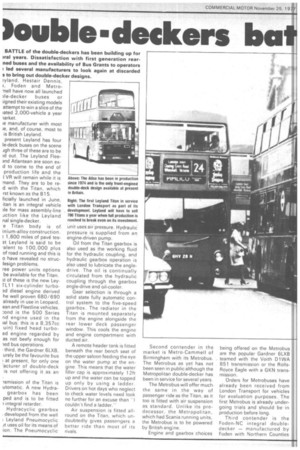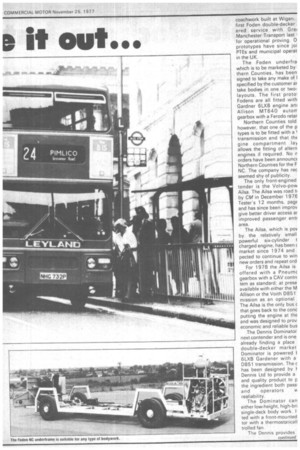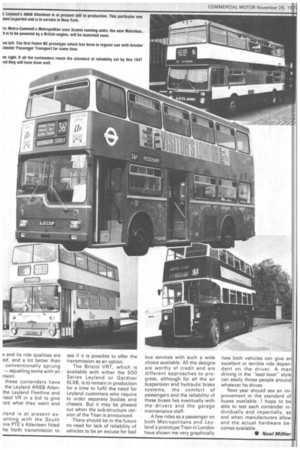Mub le-deckers WO i t Out...
Page 82

Page 83

Page 84

If you've noticed an error in this article please click here to report it so we can fix it.
BATTLE of the double-deckers has been building up for wal years. Dissatisfaction with first generation rearned buses and the availability of Bus Grants to operators led several manufacturers to look again at discarded s to bring out double-decker designs.
)yland, Hestair Dennis,
Foden and Metro-nell have now all launched )Ie-decker buses or ;igned their existing models attempt to win a slice of the iated 2,000-vehicle a year market.
le manufacturer with most le, and, of course, most to is British Leyland.
present Leyland has four le-deck buses on the scene Jgh three of these are to be )d out. The Leyland Flee]nd Atlantean are soon exd to come to the end of production life and the I VR will remain while it is -nand. They are to be re d with the Titan, which rst known as the B15. ficially launched in June, itan is an integral vehicle )Ie for mass assembly-line Jction like the Leyland nal single-decker.
e Titan body is of inium-alloy construction.
t 1,600 miles of pave tesat Leyland is said to be 'alent to 100,000 plus of road running and this is o have revealed no struciesign problems.
ree power units options be available for the Titan. ;t of these is the new Ley1111 six-cylinder turboad diesel engine derived he well proven 680/690 already in use in Leopard, ean and Fleetline vehicles. .7.ond is the 500 Series nd engine used in the ial bus: this is a 8,357cc uin) fixed head turboed engine regarded by as not beefy enough for led bus operations.
third, the Gardner 6LXB, urely be the favourite bus ! at present, for only one 'acturer of double-deck is not offering it as an
-ismission of the Titan is utomatic. A new Hydragearbox has been ped and is to be fitted ) integral retarder. Hydracyclic gearbox developed from the well Leyland Pneumocyclic st uses oil for its means of ion. The Pneumocyclic
unit uses air pressure. Hydraulic pressure is supplied from an engine-driven pump.
Oil from the Titan gearbox is also used as the working fluid for the hydraulic coupling, and hydraulic gearbox operation is also used to lubricate the angledrive. The oil is continually circulated from the hydraulic coupling through the gearbox angle-drive and oil-cooler.
Gear selection is through a solid state fully automatic control system to the five-speed gearbox. The radiator in the Titan is mounted separately from the engine alongside the rear lower deck passenger window. This cools the engine and engine compartment with ducted air, A remote header tank is fitted beneath the rear bench seat of the upper saloon feeding the eye on the water pump at the engine. This means that the water filler cap is approximately 12ft up and the water can be topped up only by using a ladder. Drivers on hot days who neglect to check water levels need look no further for an excuse than "I couldn't find a ladder."
Air suspension is fitted allround on the Titan, which undoubtedly gives passengers a better ride than most of its rivals. Second contender in the market is Metro-Cammell of Birmingham with its Metrobus. The Metrobus as yet has not been seen in public although the Metropolitan double-decker has been in service for several years.
The Metrobus will offer much the same in the way of passenger ride as the Titan, as it too is fitted with air suspension as standard. Unlike its predecessor, the Metropolitan, which had Scania running units, the Metrobus is to be powered by British engine.
Engine and gearbox choices being offered on the Metrobus are the popular Gardner 6LXB teamed with the Voith D1WA 851 transmission or the RollsRoyce Eagle with a GKN transmission.
Orders for Metrobuses have already been received from London Transport for vehicles for evaluation purposes.. The first Metrobus is already undergoing trials and should be in production before long.
Third contender is the Foden-NC integral doubledecker — manufactured by Foden with Northern Counties coachwork built at Wigan. first Foden double-decker ered service with Gre Manchester Transport last for operational proving. 0 prototypes have since joi PTEs and municipal operat in the UK.
The Foden underfra which is to be marketed by them n Counties, has been signed to take any make of I specified by the customer ar take bodies in one or twolayouts. The first proto'
Fodens are all fitted with Gardner 6LXB engine am Allison MT640 autongearbox with a Fe rode retar
Northern Counties told however, that one of the p types is to be fitted with a \ transmission and that thE gine compartment lay allows the fitting of altern engines if required. No r orders have been announcE Northern Counties for the F NC. The company has rec seemed shy of publicity.
The only front-env-led tender is the Volvo-pow Ailsa. The Ailsa was road tt by CM in December 1 976 Tester's 12 months, page and has since been improv give better driver access at improved passenger entr area.
The Ailsa, which is pay by the relatively small powerful six-cylinder t charged engine, has been c market since 1974 and pected to continue to win new orders and repeat orct For 1978 the Ailsa is offered with a Pneumc gearbox with a CAV contr( tem as standard; at prese available with either the M Allison or the Voith D851 mission as an optional The Ailsa is the only bus c that goes back to the conc putting the engine at the and was designed to prey economic and reliable bus The Dennis Dominator
next contender and is one already finding a place double-decker market Dominator is powered k 6LXI3 Gardener with a D851 transmission. The c has been designed by IDennis Ltd to provide a and quality product to p the ingredient both pass.
and operators realiability.
The Dominator can
either low-height, high-bri single-deck body work. I. ted with a front-mounted tor with a thermostaticall trolled fan
The Dennis provides a, and its ride qualities are od, and a lot better than conventionally sprung — equalling some with air nsion.
these contenders have the Leyland 4N68 Atlanthe Leyland Fleetline and -istol VR in a bid to give :ors what they want and
/land is at present exenting with the South iire PTE's Atlantean fitted he Voith transmission to see if it is possible to offer the transmission as an option.
The Bristol VRT, which is available with either the 500 Series Leyland or Gardner 6LXB, is to remain in production for a time to fulfil the need for Leyland customers who require to order separate bodies and chassis. But it may be phased out when the sub-structure version of the Titan is announced.
There should be in the future no need for lack of reliability of vehicles to be an excuse for bad bus services with such a wide choice available. All the designs are worthy of credit and are different approaches to progress, although for all the air suspension and hydraulic brake systems, the comfort of passengers and the reliability of these buses lies eventually with the drivers and the garage maintenance staff.
A few rides as a passenger on both Metropolitans and Leyland's prototype Titan in London have shown me very graphically how both vehicles can give an excellent or terrible ride dependent on the driver. A man driving in the "lead boot" style can easily throw people around whatever he drives.
Next year should see an improvement in the standard of buses available. I hope to be able to test each contender individually and impartially, as and when manufacturers allow and the actual hardware becomes available.
S Noel Miller














































































































































